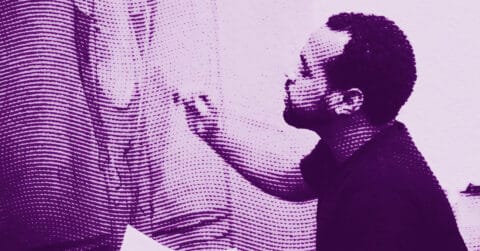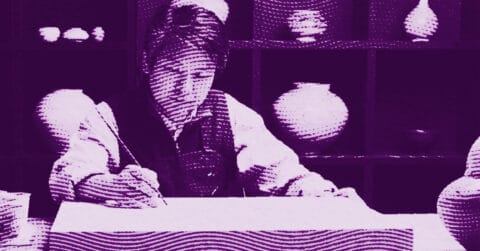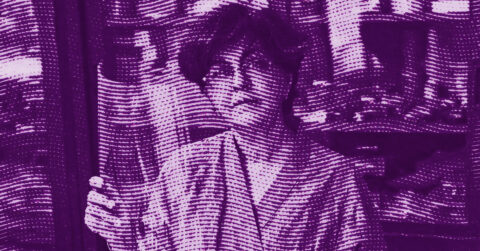Listen to me carefully, you bunch of snobs, while I talk to you about Louise Giovanelli, born in 1993 in London, who is redefining the codes of contemporary painting with a boldness that shakes the small world of contemporary art. This British artist, trained at the Manchester School of Art and the prestigious Städelschule in Frankfurt under the tutelage of Amy Sillman, is not simply painting pictures. No, she is creating a new form of visual sacrality that transcends traditional boundaries between popular culture and high culture.
Her painting technique is a genuine tour de force that deserves close attention. Inherited from Flemish masters such as Jan van Eyck and Rogier van der Weyden, it involves meticulously layering ultra-pigmented oil paints, thereby creating a luminosity that seems to emanate from the very interior of the canvas. This methodical approach is reminiscent of Walter Benjamin’s observations on the aura of works of art. But where Benjamin saw an inevitable loss of aura in the age of mechanical reproduction, Giovanelli achieves the impossible: she creates a new form of sacredness from profane images drawn from our saturated visual culture.
Her series of paintings “Orbiter” (2021) perfectly illustrates this transmutation of the profane into the sacred. By taking a simple detail from Mariah Carey’s sequined dress during a Christmas show as the subject, she transforms what might be considered a trivial moment of pop culture into a transcendent visual experience. The pictorial surface becomes a fascinating battlefield between the materiality of paint and the immateriality of light. This approach echoes Roland Barthes’ theories on photography in “Camera Lucida,” where he develops the concept of punctum. In Giovanelli’s work, every brushstroke becomes a potential punctum, creating a constant tension between the visible and the invisible that forces the viewer to slow down their gaze.
The curtains, a recurring motif in her recent work, deserve close attention. These monumental draperies, which can reach up to 3 meters in height, are not mere decorative elements or stylistic exercises. They become metaphysical gateways, thresholds between different states of consciousness. In “Prairie” (2022), a spectacular triptych, iridescent green curtains are pierced by slits of pure yellow light that create a palpable dramatic tension. This use of the curtain as an existential metaphor recalls Gaston Bachelard’s reflections in “The Poetics of Space” on the dialectics of inside and outside. Giovanelli’s curtain is no longer a simple object; it becomes a place of transition between the real and the imaginary, between the mundane and the transcendent.
But it is in her treatment of scenes from cult films that Giovanelli reveals her full subversive power. Her reinterpretation of scenes from Brian De Palma’s film “Carrie” transcends simple cinematic citation. In “Altar” (2022), she captures the precise moment when the blood falls on Sissy Spacek, transforming it into a kind of pagan epiphany. The surface of the painting vibrates with a nearly hallucinatory intensity, creating what Georges Didi-Huberman would call a “surviving image.” The saturated neons and blur effects create an unreal atmosphere that transforms this horror scene into a moment of mystical revelation.
The artist pushes her exploration of the boundaries between the sacred and the profane even further in her series “Surface to Air” (2022), where elongated legs emerge from the slit of a shimmering dress. These paintings reference the Corinthian columns of classical architecture, creating a bold parallel between sacred architecture and contemporary glamour. This unexpected juxtaposition forces us to reconsider our relationship with popular culture icons and their quasi-religious status in our society.
Giovanelli’s technique is just as remarkable as her thematic choices. Her way of working the paint with successive thin layers creates an optical depth that recalls the glazing effects of the old masters. But she uses this traditional technique to create decidedly contemporary effects. In her paintings of wine glasses, for example, she manages to create refraction and distortion effects that transform these everyday objects into vehicles for metaphysical contemplation. These contemporary still lifes remind us of 17th-century vanities, while being firmly anchored in our time.
What makes Giovanelli’s work particularly relevant today is her ability to navigate between different cultural registers with disconcerting ease. She draws as much from art history as from popular culture, creating works that resist any easy categorization. Her approach to the sacred is not nostalgic or reverential, but rather exploratory and transformative. She shows us that the sacred has not disappeared from our modern world; it has simply moved to new territories.
The treatment of light in her paintings is also particularly interesting. Rather than depicting light traditionally, she creates luminous effects that seem to emanate from within the canvas itself. This approach recalls Maurice Merleau-Ponty’s theories on the “flesh of the visible.” The textures she achieves are not mere surface effects but become tangible manifestations of that flesh of the world of which the philosopher spoke.
There is a permanent tension in her work between revelation and concealment that brings to mind Martin Heidegger’s concept of “unconcealment.” Each painting is like an aletheia, a truth that unveils itself while hiding. This dialectic is particularly evident in her close-up portrait paintings, where the subject’s identity dissolves into the pictorial matter, creating what Jacques Derrida might have called a visual “différance.”
Her way of working with repetition is also significant. By revisiting certain motifs, curtains, glasses, faces, she creates what Gilles Deleuze would call “differences in repetition.” Each iteration of a motif brings subtle variations that enrich our understanding of the subject. This serial approach recalls Claude Monet’s “Variations” on the Rouen Cathedral, but with a decidedly contemporary sensibility.
Giovanelli’s treatment of textures is particularly remarkable. Whether sequins, glass, velvet, or silk, she manages to create surfaces that are both sensual and conceptual. These textures are not simply represented; they are transfigured by the pictorial process. In her paintings, a simple velvet curtain can become as mysterious as a Veil of Veronica, as enigmatic as a Rothko painting.
Her way of framing her subjects is equally brilliant. By isolating specific details from their original contexts, she creates what Roland Barthes would call paradoxical “effects of the real.” These fragments become autonomous entities generating their own meaning. This strategy of decontextualization recalls Craig Owens’s theories on postmodern allegory, where the fragment becomes more meaningful than the whole.
Louise Giovanelli offers us a profound reflection on the very nature of representation in our image-saturated world. She transforms ephemeral moments of popular culture into lasting pictorial experiences, thus creating a new kind of contemporary iconography. Her work is not a mere critique of the society of spectacle but a bold attempt to create a new form of transcendence out of the debris of our visual culture.
Her painting reminds us that contemporary art does not need to reject tradition to be relevant. On the contrary, it is by creatively dialoguing with the history of art that she manages to create something truly new. She shows us that painting, in the 21st century, can no longer be content with being a simple medium of representation. It must become a place of alchemical transformation where the ordinary becomes extraordinary, where the profane becomes sacred. And this is precisely what Giovanelli achieves: transforming our view of the world, one brushstroke at a time.
















